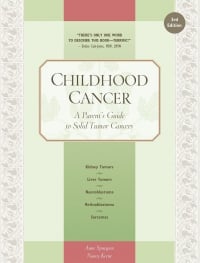Childhood Cancer
Information on standard treatments
Treatments for various types of childhood cancers evolve and improve over time. The treatments described in this chapter were the ones most commonly used (called standard treatments) when this book was written. You can learn about the newest treatments available by calling (800) 422-6237 and asking for the PDQ (physician data query) for childhood liver cancer. This free information, also available online at www.cancer.gov/cancertopics/pdq/pediatrictreatment (scroll down to “Liver cancer, childhood”) explains the disease, state-of-the-art treatments, and ongoing clinical trials. Two versions are available:
• One for families—uses simple language and contains no statistics; and
• One for professionals—is technical, thorough, and includes citations to scientific literature.
To learn about current Phase III clinical trials for liver cancers in children, visit the National Cancer Institute’s website www.cancer.gov/clinicaltrials/search and type “liver cancer, child” in the “Cancer type/condition” box and then choose Phase III in the “Trial status/phase” box. Then click the red “Search” button at the bottom of the page.

Matthew’s only symptom was an enlarged belly. He seemed to be a normal, active 18-month-old. His medical team estimated that his tumor was initially the size of a grapefruit. Four months of chemotherapy shrank the tumor to about the size of an egg, making surgery safer and more likely to be successful. Two additional months of chemotherapy were used as follow-up after his surgery. His alfa fetoprotein level returned to normal following the surgery and remained normal for 3 years, when it started to slowly climb. After ruling out all other possible causes, we knew it would only be a matter of time before our fears were confirmed. A CT scan found the liver mass.
Surgery was scheduled right away to attempt to resect the tumor. We tried several different chemotherapy protocols in the next five months, but Matthew was not improving. We met with the liver transplant team and Matthew was placed on the list. As the clock continued to tick and his AFP continued to climb, he continued on chemotherapy.
Matthew had his liver transplant. It was thrilling for us to see him recover from major surgery so quickly! At almost 2 years following his transplant, his AFP has remained normal and our hospital visits are not so frequent. Matthew played ball this past summer, completed his kindergarten year with very few absences, and is now a first grader learning to read!
Table of Contents
All Guides- Introduction
- 1. Diagnosis
- 2. Bone Sarcomas
- 3. Liver Cancers
- 4. Neuroblastoma
- 5. Retinoblastoma
- 6. Soft Tissue Sarcomas
- 7. Kidney Tumors
- 8. Telling Your Child and Others
- 9. Choosing a Treatment
- 10. Coping with Procedures
- 11. Forming a Partnership with the Medical Team
- 12. Hospitalization
- 13. Venous Catheters
- 14. Surgery
- 15. Chemotherapy
- 16. Common Side Effects of Treatment
- 17. Radiation Therapy
- 18. Stem Cell Transplantation
- 19. Siblings
- 20. Family and Friends
- 21. Communication and Behavior
- 22. School
- 23. Sources of Support
- 24. Nutrition
- 25. Medical and Financial Record-keeping
- 26. End of Treatment and Beyond
- 27. Recurrence
- 28. Death and Bereavement
- Appendix A. Blood Tests and What They Mean
- Appendix B. Resource Organizations
- Appendix C. Books, Websites, and Support Groups

